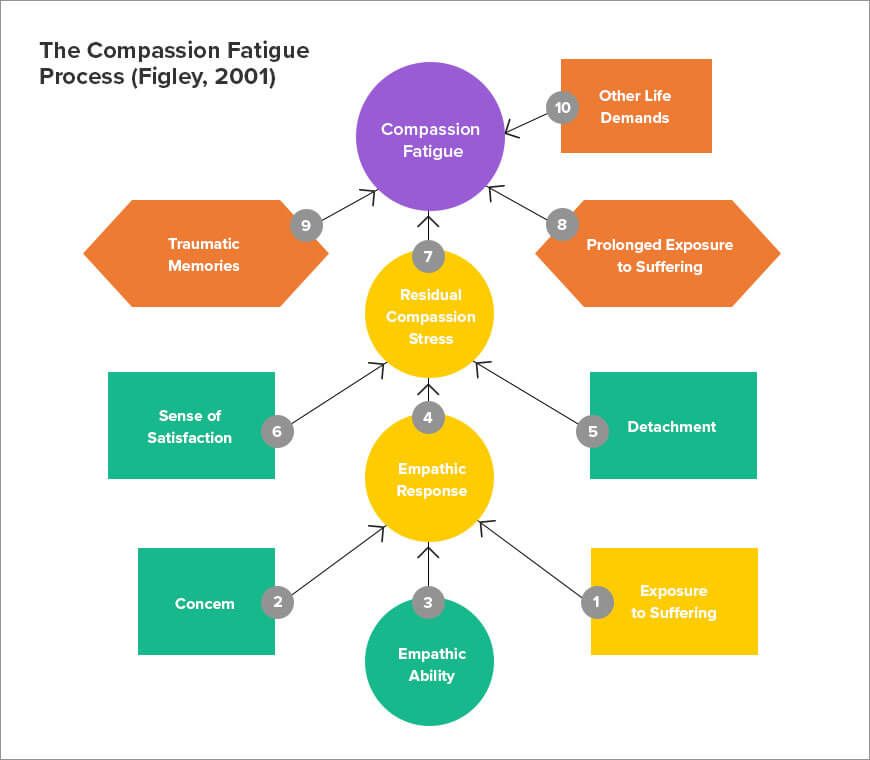Compassion Fatigue & Healthcare Professionals: An Online Guide
Learn about compassion fatigue, how to detect and manage its symptoms, and gain valuable insight into a nurse’s first hand experience
Jump To Section

Meet the Expert: Catherine Burger, MSOL, RN, NEA-BC has worked as an RN for almost 30 years in numerous patient care and leadership specialties. She has firsthand experience with compassion fatigue and secondary traumatic stress.
Working in the medical field means helping others through disease, illness, and injury. The rewards that come from this line of work are immense, but experiencing secondhand trauma can take its toll, as well. Compassion fatigue refers to the emotional, physical, cognitive, and behavioral drain that can develop in a healthcare professional, making it more difficult to empathize with those in their care.
While burnout manifests in anger, frustration, or negativity towards others, compassion fatigue often results in sadness, avoidance, nightmares, and detachment. Understanding the differences between the two and recognizing the key signs that you might be suffering from compassion fatigue represent the first (and most critical) steps to getting help. Use our self-assessment quiz, hear from nurses in the know, and find numerous resources to learn more and take action.
Compassion Fatigue Basics
Many nurses and medical professionals may be familiar with the concept of compassion fatigue, but not fully understand all the short- and long-term implications. Put simply, compassion fatigue happens when individuals become too physically, emotionally, and mentally exhausted due to the demands of the job. Given the pressure of medical work, people in these roles are at much higher risks for developing compassion fatigue than, say, an accountant.
The Process: Steps to Fatigue
Many compassion fatigue resources available today share with readers the common symptoms and how to move past them, but few offer concrete information on how someone might develop compassion fatigue in the first place.
When considering the daily responsibilities of nurses and other medical staff, it’s easy to see how the stress and secondary trauma experienced in their days can lead to compassion fatigue, but let’s take a look at each step along the way.
- Exposure to suffering
When a new patient arrives, they are often in pain, experiencing fear, and seeking reassurance that they will be okay.
- Empathetic response and concern
Medical professionals enter this field because they care about people and want to support their health. When exposed to pain and fear, doctors and nurses respond with empathy. They show natural concern about the well-being of the patient. When all goes well, medical staff enjoy feeling that they truly made a difference in someone’s life and were able to help them live a healthier existence.
- Long-term exposure to suffering
While many patients make great strides under medical care, the reality is that not all patients do. When working regularly with people who are declining, it’s easy to begin feeling residual compassion stress. When left untended, these feelings can easily manifest as traumatic memories and begin affecting the physical, emotional, cognitive, and behavioral health of doctors and nurses.
- Detachment
Under so much stress and fatigue, medical staff experiencing detachment may be unable to use their empathetic abilities when caring for their patients. They often feel like walking zombies, incapable of feeling emotions. At this point, compassion fatigue has fully taken hold.


Clearing Up Terminology
Given that compassion fatigue exists as a relatively new psychological diagnosis, there’s still a lot of ambiguity surrounding how to differentiate and define other, somewhat related, terms. There’s lots of conflicting information out there, but we’re here to bring clarity. The following table looks at some of the more common terms and helps distinguish between each.
Compassion fatigue is synonymous with secondary traumatic stress:
These terms often get used interchangeably due to the similar meanings of each phrase. Secondary traumatic stress happens when individuals witness the suffering of others or observe the suffering of individuals experiencing trauma. By witnessing the trauma of others, individuals with STS begin to feel some of the same symptoms.
Compassion fatigue is not burnout:
Burnout typically results in displeasure from work or colleagues whereas compassion fatigue results from physical and mental exhaustion. If experiencing burnout, you may feel frustrated, angry, or cynical. If experiencing compassion fatigue, you may feel sad or numb.
Compassion satisfaction is the opposite of compassion fatigue:
Compassion satisfaction occurs when people feel excited and pleased by the work they do helping others. They find meaning in their work, can see the value that they bring to the world, and feel joy about their role.
Some symptoms of compassion fatigue mimic PTSD:
According to the Mailberger Institute, PTSD and compassion fatigue symptoms often overlap, with shared signs including nightmares, difficulty sleeping, irritability, fear, flashbacks, and nightmares. The main difference between the two is that PTSD occurs when someone directly experiences trauma; compassion fatigue occurs as a result of caring for another person who went through a traumatic event, such as illness or injury.
Vicarious Trauma shares similar symptoms with compassion fatigue:
Vicarious trauma often mimics post-traumatic stress disorder (PTSD), with medical staff experiencing trauma within their inner selves as a result of exposure to patient trauma. While very similar to compassion fatigue, vicarious trauma differs in that it singularly refers to inner turmoil. Compassion fatigue, conversely, can also manifest in physical ways.
Self-Assessment Questionnaire: Are You Vulnerable?
After learning about the unique properties of compassion fatigue and how it differs from burnout, you might be wondering how (if at all) this concept fits into your life. While many medical professionals experience compassion fatigue at some point in their careers, taking time to complete a self-assessment is the first step in identifying underlying issues and seeking help. The following questionnaire can be used to help you assess whether you’re at risk or if you’re already experiencing compassion fatigue. Use the key at the end to help you determine which next steps to take.
- Do you find it difficult to feel hopeful on a regular basis?
- Does the stress of your patients’ lives affect you personally?
- Do you find it difficult to process and recover from the daily trauma of your job?
- Are you left feeling that, no matter what you do for your patients, you aren’t making a meaningful impact?
- Do you find it difficult to feel settled about your unfinished personal business?
- Do you ever find yourself withdrawing from family or friends?
- Has your use of drugs and/or alcohol increased recently?
- Have your sleeping patterns changed?
- Does it feel like those close to you don’t understand what you’re going through?
- Do you ever have flashbacks about former patients in your care?
- Are you able to leave your professional experiences at work rather than bringing them home?
- Do you feel continually tired regardless of adequate rest?
Sources:
“Overcoming Compassion Fatigue,” American Academy of Family Physicians
“Compassion Fatigue Test,” HealthyPlace.com
If you answered “yes” to five or more of these questions, you may be experiencing compassion fatigue. Review the additional warning signs and symptoms in the following section to get a better sense of whether you may need help.
Additional Warning Signs and Symptoms
Compassion fatigue can manifest in myriad ways. Some people may find that it mainly effects their emotional and physical health, while others may also notice symptoms within their behavioral and cognitive functions. Aside from using the self-assessment, be sure to review some of the common symptoms below and ask yourself if you experience any of these. It’s also important to remember that this list isn’t exhaustive; even if you identify with a few of them, it’s worth digging deeper to see if you should seek professional assistance.
| Physical | Emotional | Behavioral | Cognitive |
|---|---|---|---|
| Headaches | Sadness | Addiction | Nightmares |
| Digestive problems | Grief | Overusing sick days | Inability to concentrate |
| Muscle tension | Inability to feel empathy | Disturbances in relationships | Shifts in beliefs |
| Fatigue | Feelings of dread | Shifts in sleeping | Avoidance |
Developing a Self-Care Plan to Manage Your Compassion Fatigue
After recognizing the signs and symptoms of compassion fatigue within yourself, it’s important to develop a multi-pronged approach. In addition to seeking professional support, you can also create a self-care plan to help put yourself on a road to recovery. When thinking about self-care, remember that you need to address six core areas: physical, psychological, emotional, spiritual, professional, and relational health. By creating a holistic plan, you can adequately monitor improvements along the way in each of these key areas.
When reviewing the table below, don’t feel you need to do everything. Instead, try to pick one or two strategies and/or activities from each section that you can focus on. After working on these for several weeks, consider your current feelings against the list of signs and symptoms. Can you see improvements in these areas? If one of your focuses has been improving positive self-talk about work, can you sense improvements in how you think about challenging days? Keep these measurements in mind as you work through strategies. It’s also important to remember that self-care is never a substitute for professional care.
| Physical | Psychological | Emotional | Spiritual | Professional | Relational |
|---|---|---|---|---|---|
| Commit to a healthy diet | Work with a counselor/therapist | Spend time with people you love | Listen to/watch inspiring music or programming | Alter shift patterns | Cut out any toxic relationships |
| Create a calming space to come home to | Journal about your days and leave the bad experiences on the page | Create a list of self-affirmations | Spend time in nature | Take plenty of breaks | Identify individuals at work who can check in on you |
| Create bedtime routines and stick with them | Think about the positives at work | Make sure to laugh and cry; don’t hold emotions in | Create lists of things that give you hope/faith | Create a peer support group | Spend ample time with trusted friends and family |
| Find a physical activity you enjoy | Confide in a friend/colleague | Find an enjoyable volunteer activity | Post inspirational quotes in your personal space | Ask for mentor/supervisor meetings | Seek support from your partner/spouse |
| Take time away from work for vacations or visiting friends/family | Decrease stressful situations in your personal life | Keep a running list of moments that made you feel strong | Take part in a religious service | Create boundaries | Maintain boundaries with patients and coworkers |
How to Avoid Compassion Fatigue: Preventative Care
While much of this guide focuses on identifying whether you have compassion fatigue and providing actionable advice about how to come out of that season, it’s also important to implement preventative measures that can keep you from feeling drained in the first place. Tips for creating preventative measures include:
1. Know that putting yourself first isn’t selfish
It can be easy to feel that, in the face of pain and suffering, your needs and health should take a back seat as they seem less pressing. As the old adage goes, however, you cannot pour from an empty cup. By neglecting your needs and ignoring internal cues, you’re actually limiting your ability to adequately care for others.
2. Create emotional boundaries
When caring for someone experiencing trauma, illness, or disease, setting boundaries can feel difficult. Our natural instinct as humans is to show empathy and care when exposed to another person’s suffering. While it may seem counterintuitive, being able to set and maintain boundaries actually allows you to care for individuals more fully because you can take a holistic view of their needs rather than getting too close to be objective.
3. Find your support network
Whether comprised of work colleagues who understand your daily challenges or of those who work in different industries, social support networks help us recharge and feel known by others. Whether participating in a book club, grabbing a coffee, or playing board games, surrounding ourselves with others who know us well provides an opportunity for replenishment. These friends may also be able to identify signs of compassion fatigue you didn’t yet recognize in yourself.
Sources:
“Preventing Compassion Fatigue,” Marysville University

(Interview) A Nurse’s Experience with Compassion Fatigue
Catherine Burger, MSOL, RN, NEA-BC has worked as an RN for almost 30 years in numerous patient care and leadership specialties. She now owns her own consulting business and enjoys writing about nursing.
1. How/when did you first learn about secondary traumatic stress and compassion fatigue?
I first learned the technical name when I began managing a large intensive care unit (ICU) for a health management organization in Northern California. We were the Neuro Center of Excellence for the health system and provided care for very tragic cases. These nurses were caring for patients during the most vulnerable times of their patients’ lives, which often brings out the worst behaviors. Patients or families would sometimes become angry, or even violent, against the staff because they were scared or hurting. When I first assumed the manager role, I realized quickly that my nurses were extremely compassion fatigued. In spite of the excellent care they provided, they were emotionally tapped-out when patients or families were unappreciative, rude, or inappropriate.
2. When did you know you were dealing with symptoms?
I knew that I was fatigued in my compassion when I began to dissociate from my patients, had diminished empathy for them, and was getting frustrated easily.
As a nursing leader, I experienced compassion fatigue with regards to my staff. There were times when I became less empathetic to their personal issues, especially when I had many initiatives or deadlines to meet as the leader of the department.
3. What are some steps you took to address compassion fatigue?
As a direct-care nurse, I actually left the ICU and went to home health where I experienced more autonomy and less overall stress. I was able to reconnect with my passion for nursing to provide care for patients and believed that I could make a difference in their lives. As a nursing leader, I sought out mentors who could help me re-frame my mindset for the challenges I was facing with certain staff. Also, I attended coaching sessions with a professional business coach who really helped me define the type of leader I wanted to become and the leadership traits that I wanted to avoid.
4. How long did it take to come out of that season?
As a staff nurse, took me several months to renew my sense of nursing purpose and connect on a deeper level with my patients. As a nursing leader, it was not so much that I came out of the season, it was more that I was able to recognize when I was losing empathy and interest and so I would take steps to reinvigorate my commitment to the department and staff.
5. How do you stay proactive to guard against compassion fatigue?
The best way to ensure that I’m guarding against the weariness is by taking care of myself first, before caring for others. If I am eating healthy, sleeping at least seven hours at night, and getting daily exercise, I am less irritable overall and can reframe my attitude for those that need so much from me. Another method I use, as a nursing leader, is to make sure that I’m seeking new challenges for myself and for the department that I lead. For example, if the executive team is looking for a department to pilot a product or study, I volunteer my unit. If I read about an innovative way to provide care or processes, I enlist a core group of staff to brainstorm on how we can implement a change. I also try to keep myself grounded by sharing my challenges with colleagues and mentors to gain more perspective and insight.
6. Are there particular resources you’ve sought out?
I enjoy reading books about positive living and leadership such as Brene Brown’s “The Gifts of Imperfection” or “Dare to Lead.” Other books that I listen to while driving (which I have found is the best way for me to get through a lot of books) are the Rachel Hollis books that renew my belief in myself. I also search online articles on compassion fatigue to learn more about the topic and what other self-improvement techniques I can implement.
Another resource that I tap into is the human capital side of nursing leadership. Since the people who do the work have the answers, I utilize the staff nurses in workgroups for many of the “problems” in the unit, which saves me from burnout and fatigue. Many staff love to provide input and, with little “managing” from me, they typically produce a product or process that is sustainable because it is coming from the front line.
7. What advice would you give to healthcare professionals in a similar situation?
There are many ways to guard against compassion fatigue. In the ICU I managed, we started a Caritas Committee where staff could engage in activities that focus on caring. This was based on nursing theorist Dr. Jean Watson’s work in caring science, which includes not only love and compassion for others, but care for yourself as well. As nurses, we tend to automatically assume the care we need to give is for our patients and then ourselves. However, we forget and fail to acknowledge the care we need to show for our colleagues. Many studies show that teams or departments that believe and feel they are cared for by their teammates thrive. Patient satisfaction scores are higher and fewer errors occur. I would be willing to bet that the nurses on those caring teams experience significantly less compassion fatigue.
Other advice I would offer to nursing leaders is to have mandatory formal debriefing sessions for the staff during or after a particularly challenging case. Nurses need to believe that their feelings and emotions are being acknowledged by their leadership team. The debriefing process, facilitated by trained professionals, is a structured method that will assist nurses in staying connected to their feelings and therefore reduce the incidences of compassion fatigue.
Many facilities offer an Employee Assistance Program where staff can seek short-term counseling to get them back to a healthy patient engagement. Nurses and nursing leaders should be sharing the availability and benefits of these free programs.
Resources to Take Action Against Compassion Fatigue
Still looking to learn more about compassion fatigue and how to combat it? The additional resources in this section can help you figure out whether compassion fatigue is creeping into your life and provide practical and actionable tools for handling them.
- Compassion Fatigue Self-Test: The Compassion Fatigue Awareness Project provides a life stress self-test and an empathy test to help readers see where they stand on the scale.
- The Toll of Being a Care Provider: The Association of American Medical Colleges offers a look at the state of compassion fatigue and burnout in the medical profession, demonstrating the widespread issues.
- Professional Qualify of Life Scale: Looking to get answers about why you might be feeling down about work? Tend provides a professional qualify of life scale quiz to help you ascertain your compassion satisfaction, burnout, and secondary trauma scales.
- I Left Nursing Because of Secondary Traumatic Stress: If you’re feeling alone, know that others experience these same issues. Reflections on Nursing Leadership shares the story of former nurse, Dorothy Wright.
- Compassion Fatigue vs. Burnout: 3 Tools: Some individuals may not fully understand the differences that exist between burnout and compassion fatigue. Psych Central explains how they differ and offers tools to combat both.
- The Secondary Traumatic Stress Informed Organization Assessment Tool: The University of Kentucky’s Center on Trauma and Children provides this tool for organizational leaders to evaluate the degree to which their organization’s practice is STS informed.
- Compassion Fatigue – Are You At Risk?: American Nurse Today provides an overview of how compassion fatigue happens, what it looks like, and how to identify risk factors.
- Strategies that Reduce Compassion Fatigue and Increase Compassion Satisfaction: Individuals looking for a more scientific view of compassion fatigue can review this academic journal article and gather tips.


